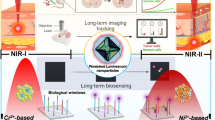Abstract
Detection of apoptotic cells is crucial for understanding the mechanism of diseases and for therapy development. So far, visible-emitting fluorescent probes such as FITC-labeled Annexin V has been widely used for the detection of apoptotic cells. However, such probes cannot be applied to noninvasive imaging in the near-infrared (NIR) region. Compared with visible light, NIR light is highly permeable in turbid biological samples and tissues. In addition, NIR optical imaging has several advantages such as lower autofluorescence and scattering from biological samples, leading to clearer images with high signal to background ratios. Here, we describe the synthesis and application of bioluminescence resonance energy transfer (BRET)-coupled quantum dots (QDs) for the NIR optical imaging of apoptotic cells.
Access this chapter
Tax calculation will be finalised at checkout
Purchases are for personal use only
Similar content being viewed by others
References
Taylor RC, Cullen SP, Martin SJ (2008) Apoptosis: controlled demolition at the cellular level. Nat Rev Mol Cell Biol 9:231–241
Fuchs Y, Steller H (2015) Live to die another way: modes of programmed cell death and the signals emanating from dying cells. Nat Rev Mol Cell Biol 16:329–344
Elmore S (2007) Apoptosis: a review of programmed cell death. Toxicol Pathol 35:495–516
Fuchs Y, Steller H (2011) Programmed cell death in animal development and disease. Cell 147:742–758
van Genderen HO, Kenis H, Hofstra L, Narula J, Reutelingsperger CP (2008) Extracellular annexin A5: functions of phosphatidylserine-binding and two-dimensional crystallization. Biochim Biophys Acta 1783:953–963
Lizarbe MA, Barrasa JI, Olmo N, Gavilances F, Turnay J (2013) Annexin-phospholipid interactions. Functional implications. Int J Mol Sci 14:2652–2683
Nazari M, Minai-Tehrai A, Emamzadeh R (2014) Comparison of different probes based on labeled annexin V for detection of apoptosis. RSC Adv 4:45128–45135
Koopman G, Reutelingsperger C, Kuijten G, Keehnen R, Pals S, Van Oers M (1994) Annexin V for flow cytometric detection of phosphatidylserine expression on B cells undergoing apoptosis. Blood 84:1415–1420
Petrovsky A, Schellenberger E, Josephson L, Weissleder R, Bogdanov A Jr (2003) Near-infrared fluorescent imaging of tumor apoptosis. Cancer Res 63:1936–1942
Hasegawa M, Tsukasaki Y, Ohyanagi T, Jin T (2013) Bioluminescence resonance energy transfer coupled near-infrared quantum dots using GST-tagged luciferase for in vivo imaging. Chem Commun 49:228–230
Samanta A, Walper SA, Susumu K, Dwyer CL, Medinz IL (2015) An enzymatically-sensitized sequential and concentric energy transfer relay self-assembled around semiconductor quantum dots. Nanoscale 7:7603–7614
Yu X, Wen K, Wang Z, Zhang X, Li C, Zhnag S, Shen J (2016) General bioluminescence resonance energy transfer homogeneous immunoassay for small molecules based on quantum dots. Anal Chem 88:3512–3520
Kamkaew A, Sun H, England CG, Cheng L, Liu Z, Cai W (2016) Quantum dot–NanoLuc bioluminescence resonance energy transfer enables tumor imaging and lymph node mapping in vivo. Chem Commun 52:6997–7000
Weissleder R (2001) A clearer vision for in vivo imaging. Nat Biotechnol 19:316–317
Srikantha T, Klapach A, Lorenz WW, Tsai LK, Laughlin LA, Gorman JA, Soll DR (1996) The sea pansy Renilla reniformis luciferase serves as a sensitive bioluminescent reporter for differential gene expression in Candida albicans. J Bacteriol 178:121–129
Jin T, Yoshioka Y, Fujii F, Komai Y, Seki J, Seiyama A (2008) Gd3+-functionalized near-infrared quantum dots for in vivo dual modal (fluorescence/magnetic resonance) imaging. Chem Commun 44:5764–5766
Jin T, Fujii F, Komai Y, Seki J, Seiyama A, Yoshioka Y (2008) Preparation and characterization of highly fluorescent, glutathione-coated near infrared quantum dots for in vivo fluorescence imaging. Int J Mol Sci 9:2044–2061
Medintz IL, Uyeda HT, Goldman ER, Mattoussi H (2005) Quantum dot bioconjugates for imaging, labelling and sensing. Nat Mater 4:435–446
Lao UL, Mulchandani A, Chen W (2006) Simple conjugation and purification of quantum dot-antibody complexes using a thermally responsive elastin-protein L scaffold as immunofluorescent agents. J Am Chem Soc 128:14756–14757
Alam R, Karam LM, Doane TL, Zylstra J, Fontaine DM, Branchini BR, Maye MM (2014) Near infrared bioluminescence resonance energy transfer from firefly luciferase-quantum dot bionanoconjugates. Nanotechnology 25:495606. (7pp)
Author information
Authors and Affiliations
Corresponding author
Editor information
Editors and Affiliations
Rights and permissions
Copyright information
© 2020 Springer Science+Business Media, LLC, part of Springer Nature
About this protocol
Cite this protocol
Tsuboi, S., Jin, T. (2020). Bioluminescence Resonance Energy Transfer (BRET) Coupled Near-Infrared Imaging of Apoptotic Cells. In: Ripp, S. (eds) Bioluminescent Imaging. Methods in Molecular Biology, vol 2081. Humana, New York, NY. https://doi.org/10.1007/978-1-4939-9940-8_2
Download citation
DOI: https://doi.org/10.1007/978-1-4939-9940-8_2
Published:
Publisher Name: Humana, New York, NY
Print ISBN: 978-1-4939-9939-2
Online ISBN: 978-1-4939-9940-8
eBook Packages: Springer Protocols




